Without doubt the Eiffel Tower is the most recognized and photographed icon in Paris, having towered 1063′ above the Parisienne skyline since 1889 when it was erected to serve as the entrance way to the 1889 World’s Fair. The tower is the tallest structure in the city of Paris and was in fact the tallest man-made structure in the world from its completion (surpassing the Washington Monument) for forty one years until it was dwarfed by the Chrysler Building in New York City in 1930.
The Eiffel Tower was the winning submission in a contest to design the grand entrance way to the 1889 World’s Fair and the contest rules included that the structure would be easily constructed and easily dismantled. For this reason the tower metalwork was designed to be fastened only with rivets and bolts. The temporary nature of the tower is shown in that Gustave Eiffel was only awarded a twenty year permit for the tower (until 1909) at which time the ownership of the tower was slated to be returned to the city of Paris for demolition. The tower however proved invaluable not only for tourism, but also for radio and television broadcasting, so fortunately the tower remains today, and has become the world’s most visited paid tourist attraction with about seven million paying visitors every year. Deb & I were glad to pay about 18€ each to visit the top of the tower.
While preparing for our trip to Paris, we found that there are many, if not hundreds, of replicas of the Statue of Liberty around the world. The most famous Lady Liberty who overlooks New York City from Liberty Island was a gift to the United States from France. The original statue is in Luxembourg Gardens in Paris and a second replica was erected at the tip of a small man made island in the River Seine in 1889 for the World’s Fair. Knowing it was there we set out to take a picture of the Statue of Liberty with the Eiffel Tower as a back drop. It turned out to be a seven kilometre excursion but was worth the effort to get this rather unique image.
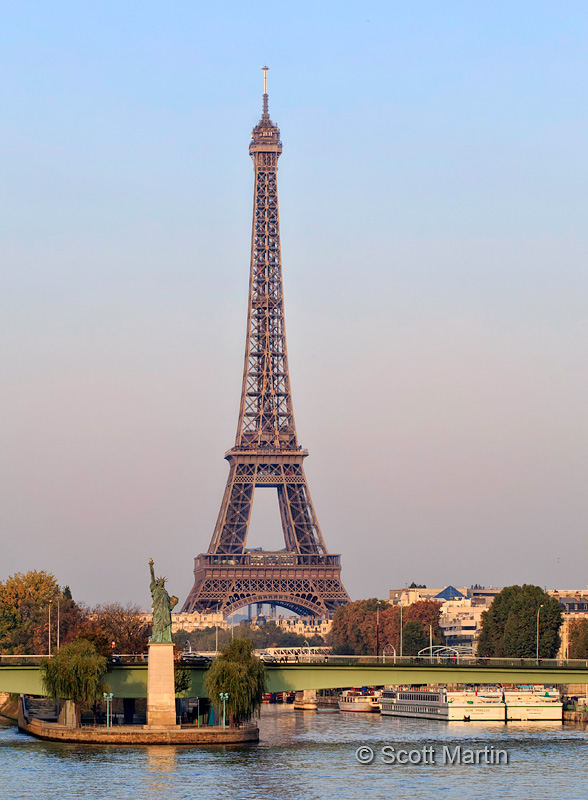
.
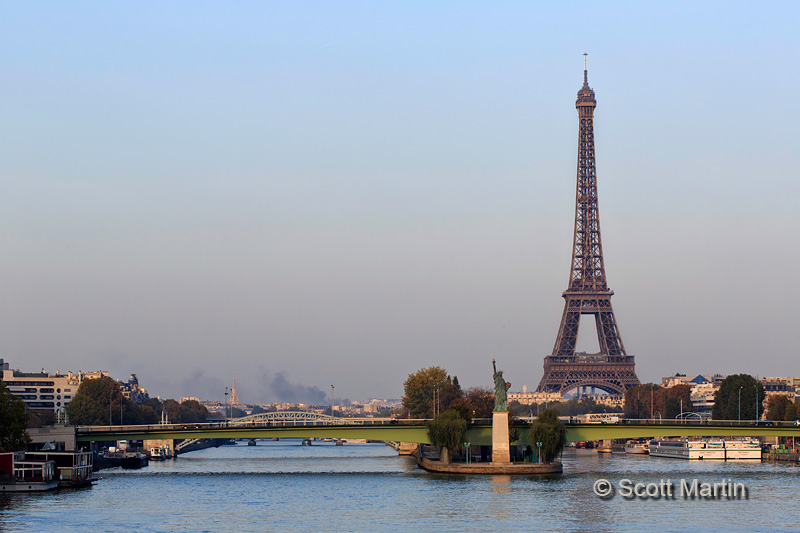
Being one of the most recognizable and photographed land marks in the world means that it is virtually impossible to take a novel picture of the tower, however Deb and I tried to find some unique perspectives and we hope you enjoy them.
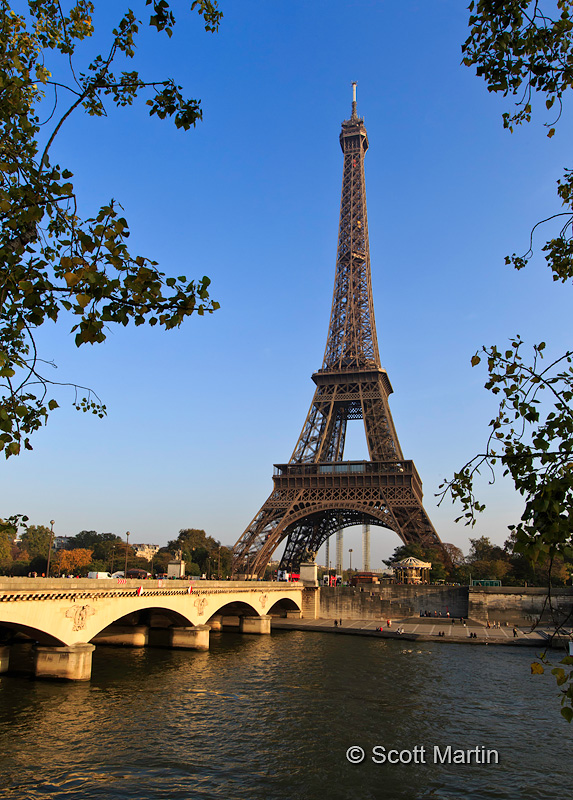
It is good practice to change the secondary compositional elements in an image if possible as a very different result can be achieved even if the perspective of the primary subject is virtually the same. The image above uses trees in the foreground to provide some visual interest and frame the tower while the image below provides an uncluttered view of the tower from the same perspective, however includes a river ferry as a secondary object of interest. Two very different images of the same primary subject from the same perspective. Some may prefer one over the other, which is merely subjective, however good practice is to take both and give people the choice!
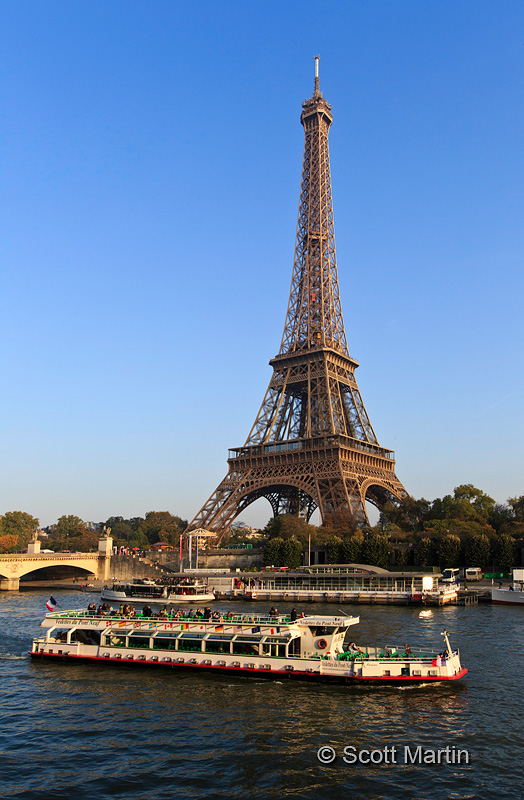
Although the tower is most often photographed to include the Seine River, it also looks good from the Champ de Mars which is the extensive parkland to the east of the tower. Thankfully there were great clouds which add to the pictures. Brian Peterson, in his classic book “Understanding Exposure” says that the best time to take a vertically orientated image is after you’ve already taken one in a horizontal orientation! While generally good advice, the Eiffel Tower lends itself to portrait orientation. It is interesting how the two camera orientations (portrait & landscape) create very different results as shown below.
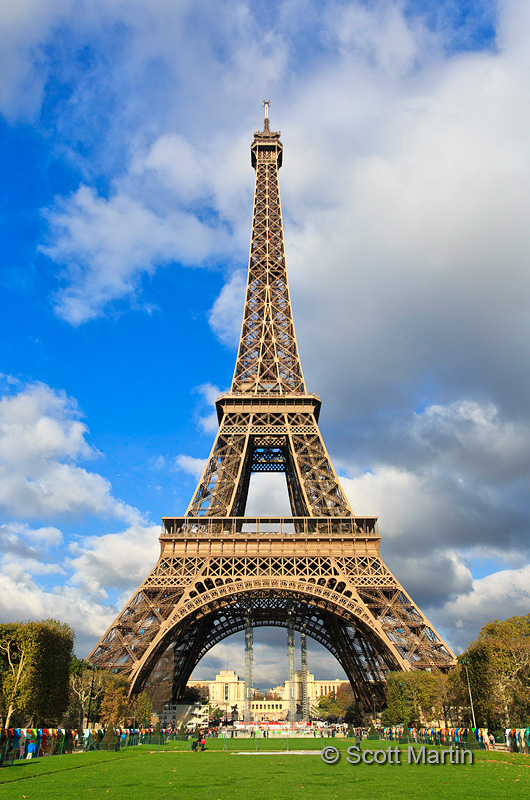
When photographing the tower with a wide angle lens (16-35/2.8 in this case) in landscape orientation you are pretty much forced to put the tower in the centre of the frame to avoid the distortion that is created when the tower is located near the edges of the frame. Distortion can be minimized by making sure the camera is level, however the height of the tower requires some upwards tilting of the camera which exacerbates the distortion.
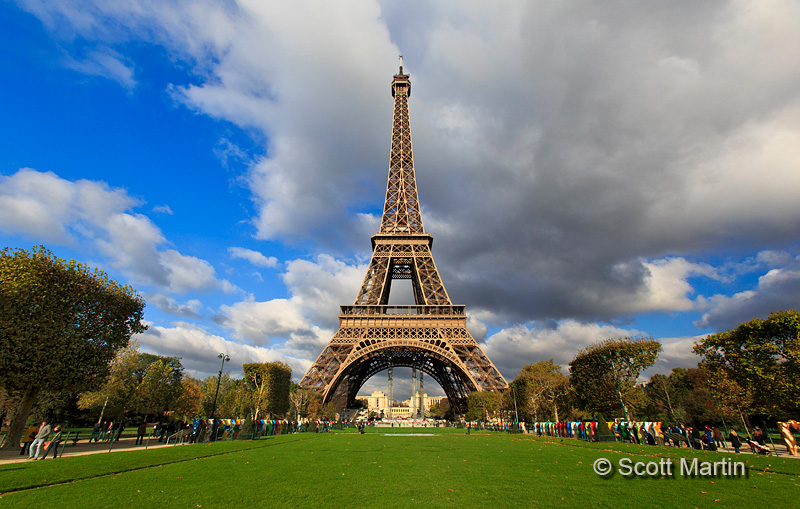
The above two images show us that its always a good idea to take images using both camera orientations as a general practice. One may be decidedly better than the other but you amy never know which one is the best if you don’t practice taking both!
Breaking the rules of composition is easy to do when photographing the tower and even images missing the ground (a cardinal no no) sometimes turns out no too badly as shown below.
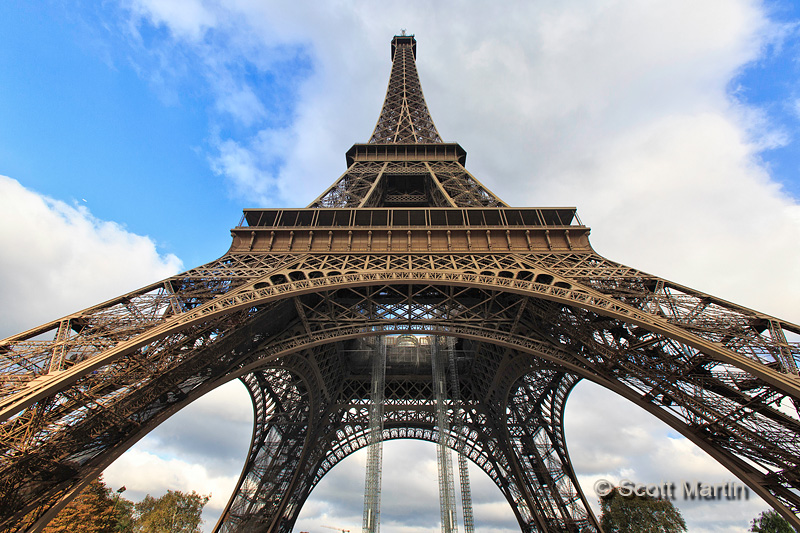
Getting to the top of the Eiffel Tower requires two elevator rides, a very unique two story elevator that angles up two of the four tower bases to the first level of the tower and then a second, much smaller traditional elevator that rises straight up to the second level. Even when arriving to the top of the second elevator you are required to climb a couple of flights of stairs to arrive at the outside upper observatory, but the view that awaits is spectacular. Below is the second elevator.
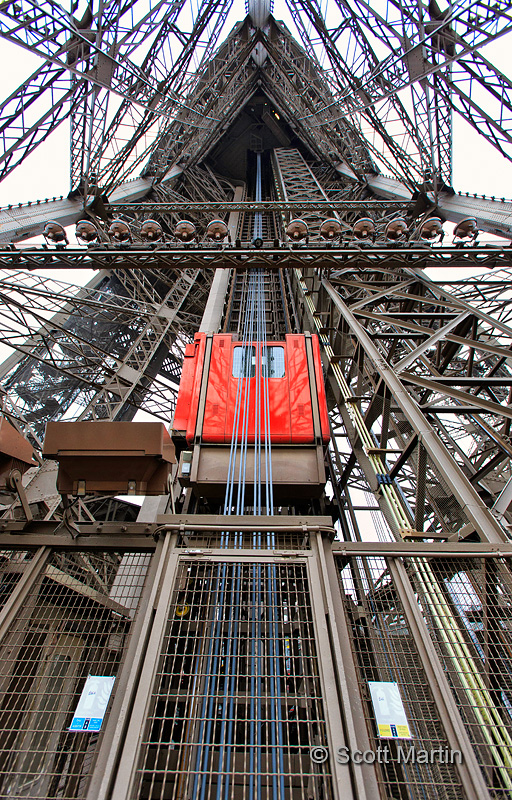
The views of Paris from the Eiffel Tower are grand as you can easily see the historic landmarks of the city. Looking west from the lower observation deck across the River Seine is the Place du Trocadéro and the expansive Palais de Chaillot which houses a number of museums. In the back ground is the skyline of ‘modern’ Paris.
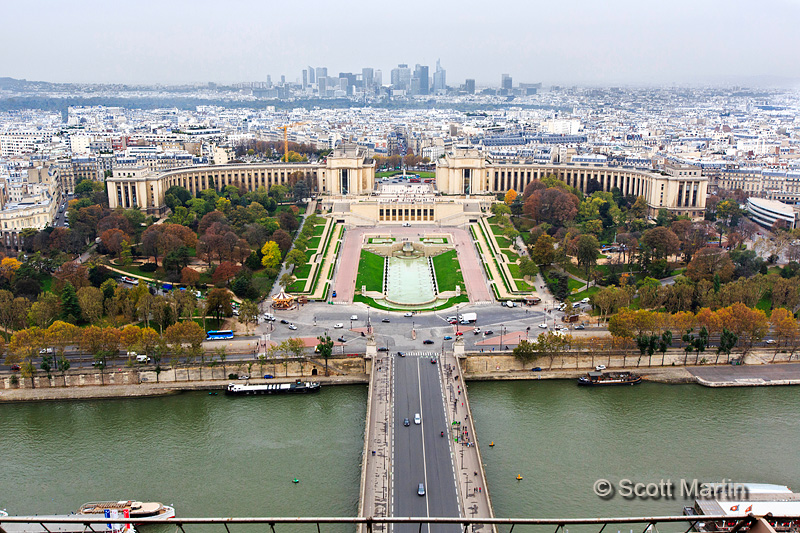
From the upper observation deck the perspective is completely different and allowed me the opportunity to use the 100 mm f/2.8 macro lens as a short telephoto lens (If you’ve been following this blog you will require that my beloved 24-105 broke in Venice). Below is the Arc du Triomphe as seen from the top of the Eiffel Tower.
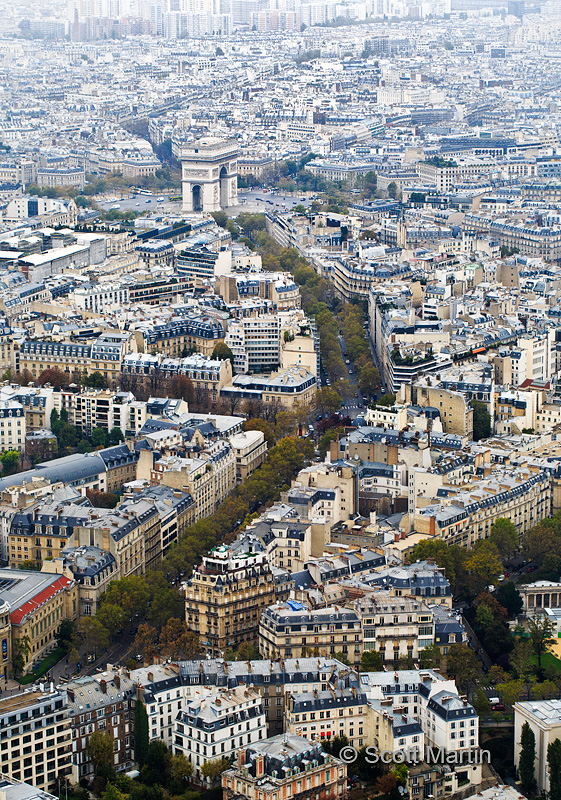
Photographing the Eiffel Tower at night is something that every photographer wants to do at some point in time, capturing that iconic shot. We spent two evenings shooting the tower at night and a light rain made one of those evenings a bit challenging.
For me the classic Eiffel Tower at night shot is taken from across the Seine River, one view highlighting the arches of the bridge and the other the string of streetlights leading towards the tower. So we took those two shots first!
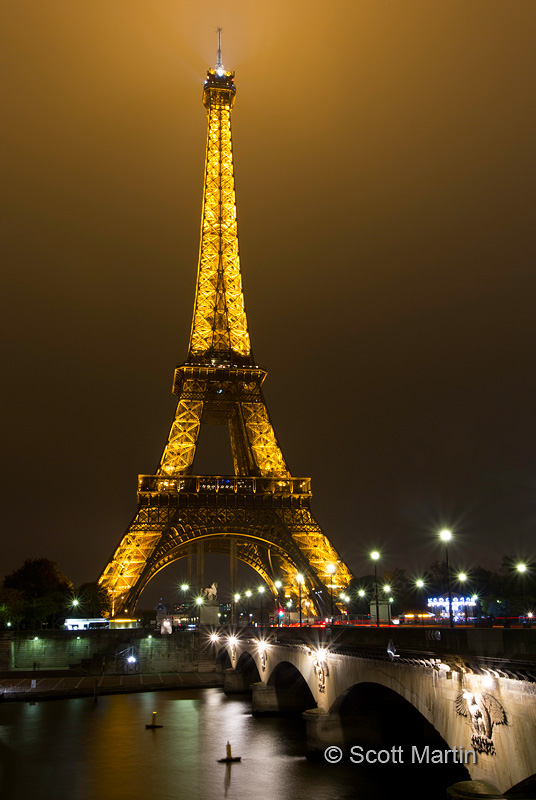
.
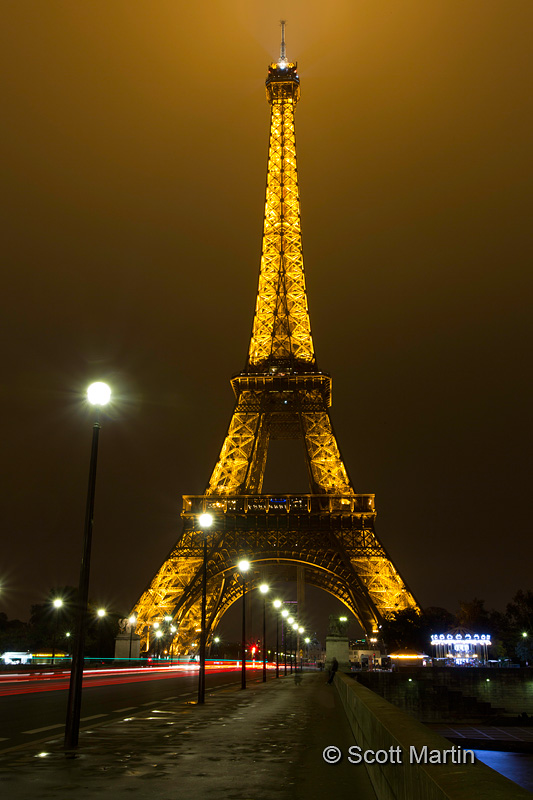
A view from about half a kilometre away.
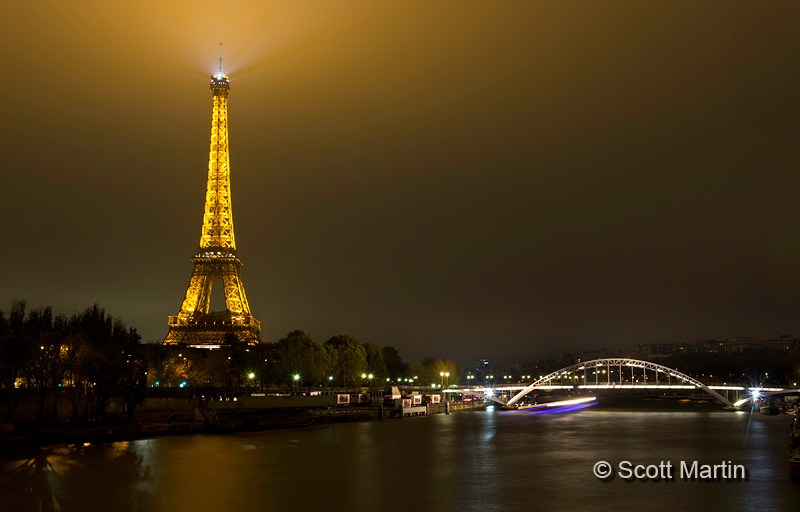
Images taken from near the tower pose a problem as wide angle lenses are required and tilting them upwards to include the tower also creates optical distortions that can be problematic. That said, you should always play around with different angles and compositions until you find something that works. Using a tripod, which is essential for night photography, forces you to constantly think about composition simply because of the discipline involved with setting up the tripod and choosing where to place it. Simply by using a tripod all the time, day or night, will quickly improve your skills. Its been said the biggest difference between a professional and amateur photographer is the tripod!
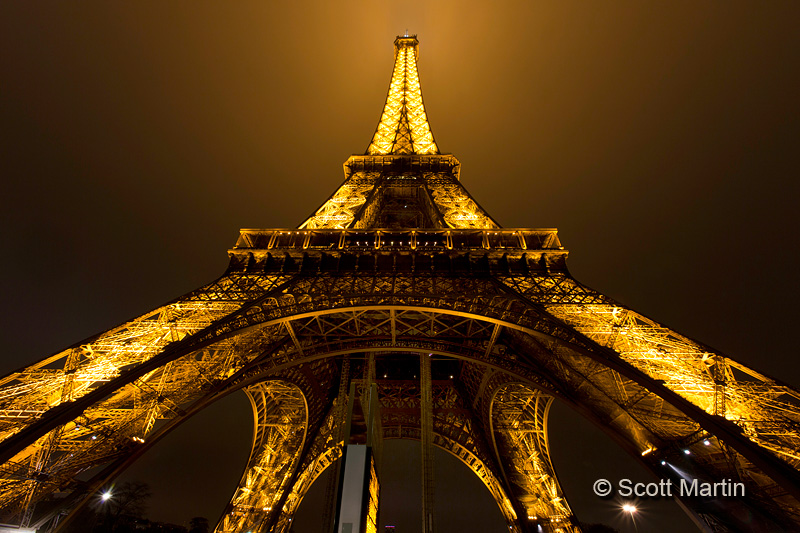
.
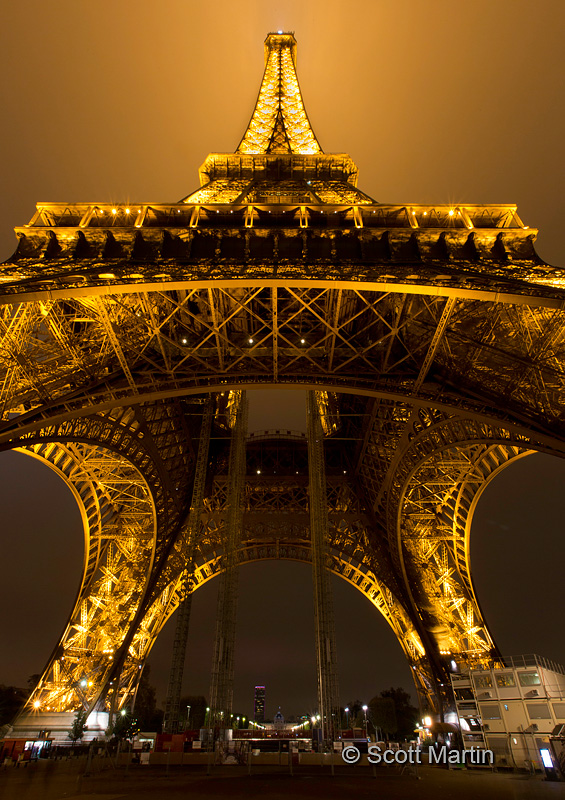
Another commonly seen image of the tower is with the Eiffel Tower Carousel in the foreground. Once the tripod was set up, there were only two shots to be taken, one with a slow shutter speed to blur the moving carousel and one with the carousel stationary.
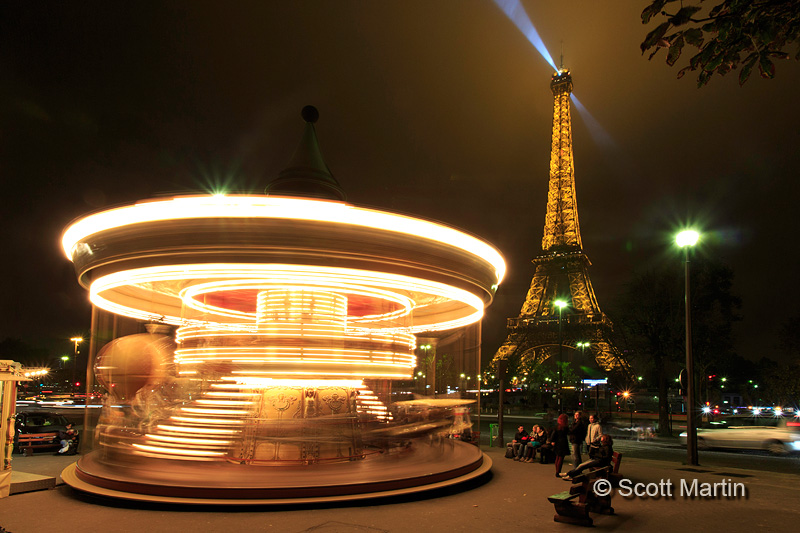
.
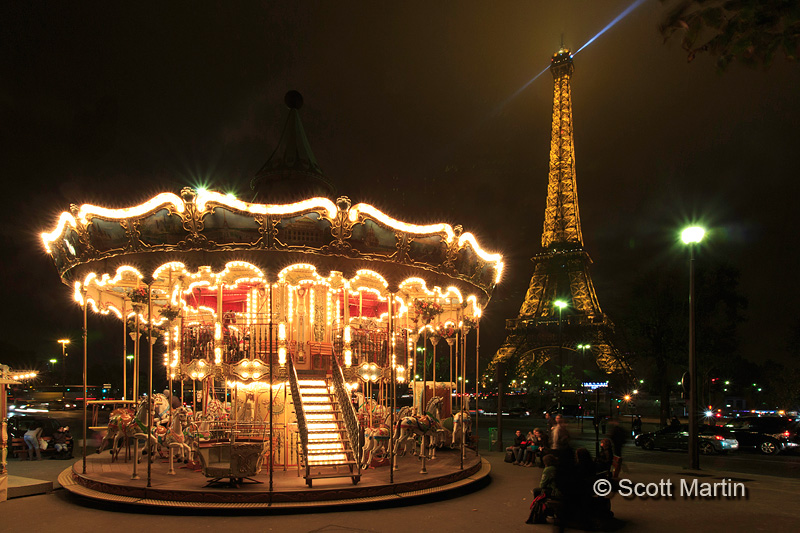
The remaining images in this post were taken the second night which is evident by the very different sky. The next two images use the impressive fountains of the Place du Trocadéro to provide some fore ground interest for the tower.
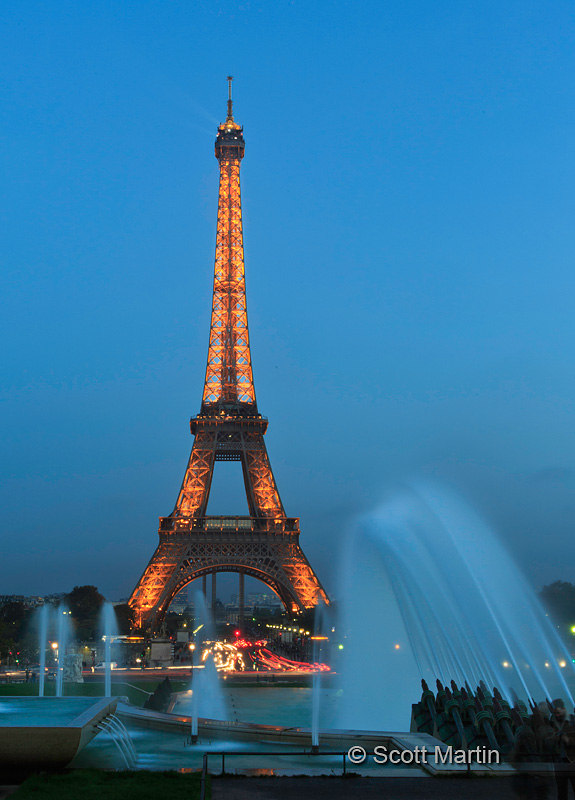
Every night, on the hour, the Eiffel Tower twinkles for about five minutes with a spectacular light show created by 20,000 individual lights. They blink randomly and make the tower appear to be shimmering, however when photographed with a long exposure all the lights are recorded which demonstrates the lattice pattern of the lights on the iron tower structure.
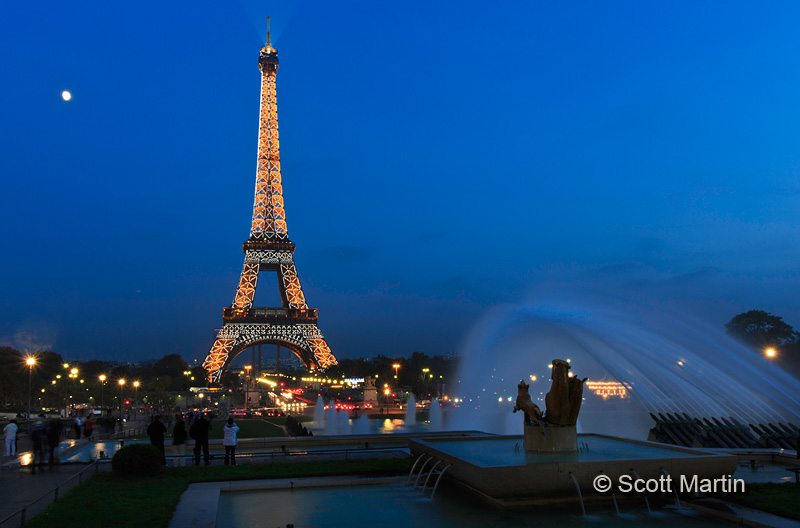
The moon was a bonus for us on this evening.
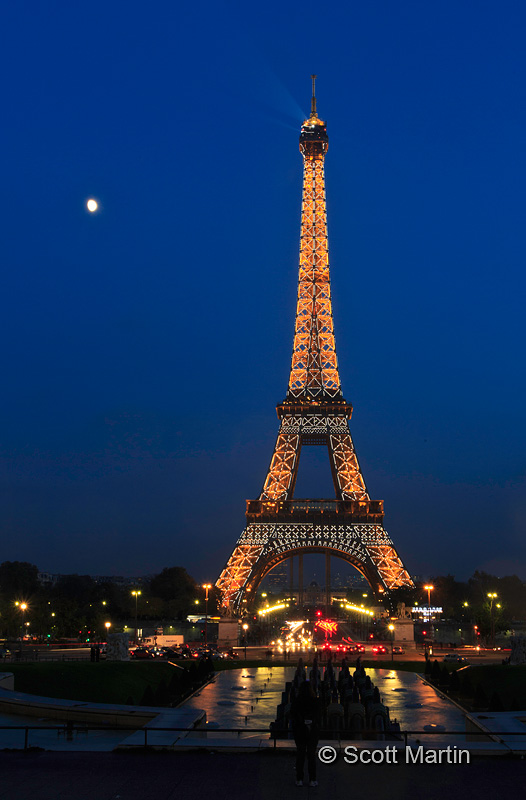
.
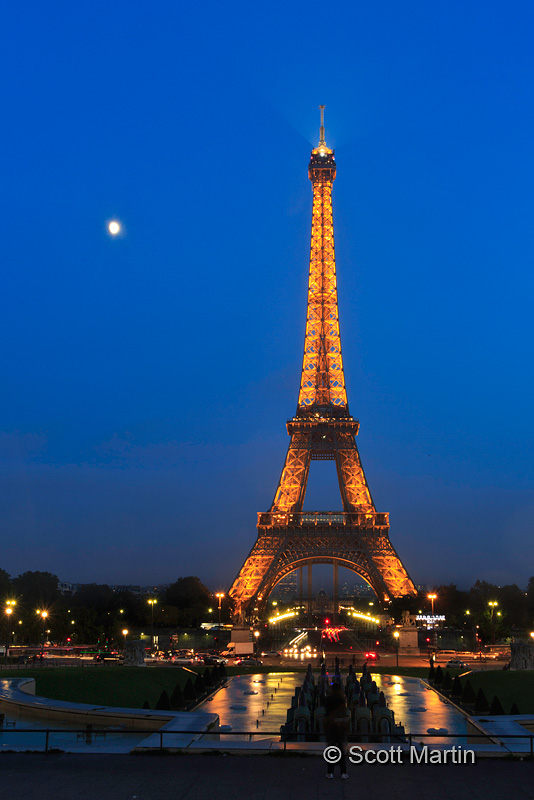
The next two images are identical except for the exposure, however different exposures make for very different results. The first is a low ISO, long exposure, small aperture shot that blurs the tower beacon.
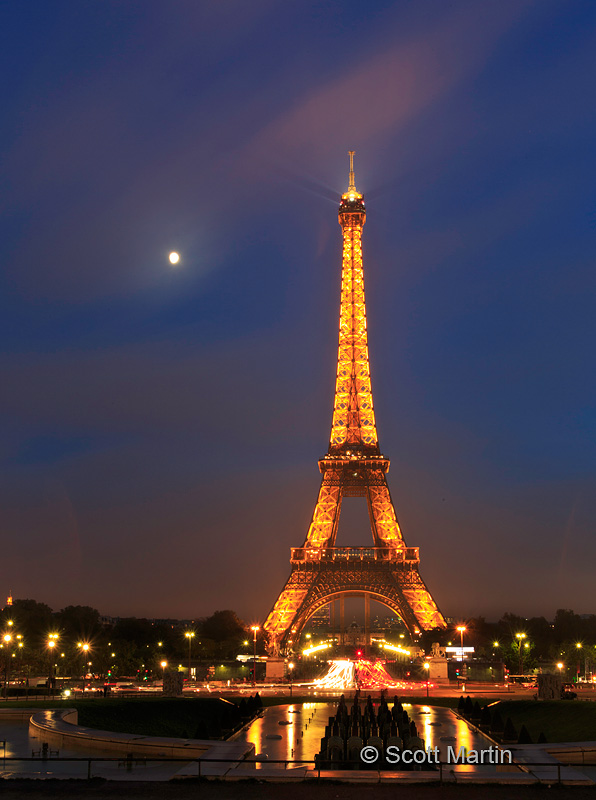
The next image was taken with a high ISO and larger aperture to allow for a fast shutter speed which ‘freezes’ the beacon atop the tower creating a rather dramatic effect. I took a number of these shots with the beam in many different orientations but this one seemed the most aesthetically pleasing.
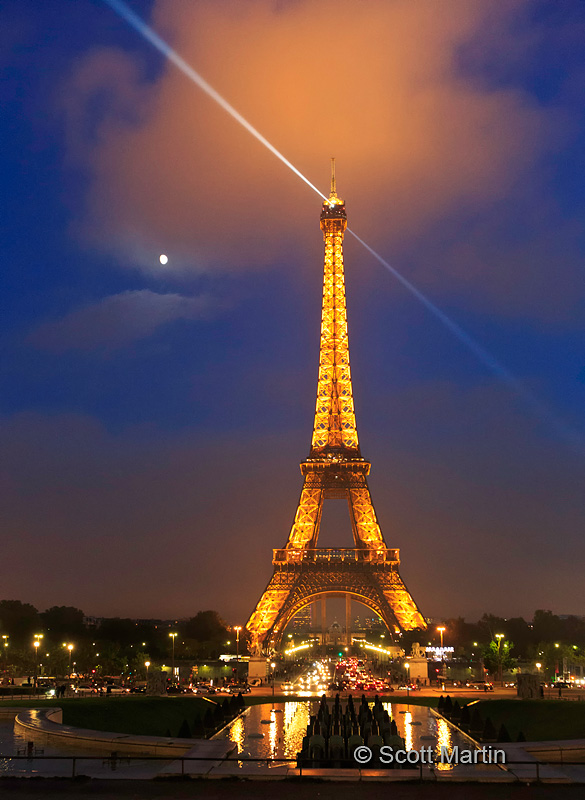
The last two images in this post were taken just after sunset when it was starting to get dark. They are not really Eiffel Tower pictures but rather of the lone busker, who presumably after many hours of singing and after it was starting to get dark, stayed and kept whole-heartedly singing, even though there was no one left on the large patio to hear his voice or toss some coins into his guitar case. It was a huge testament to his character and perseverance.
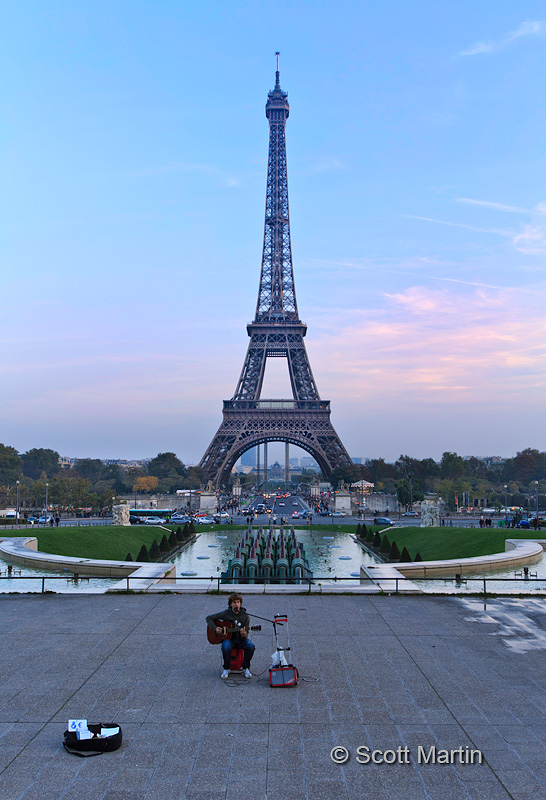
.
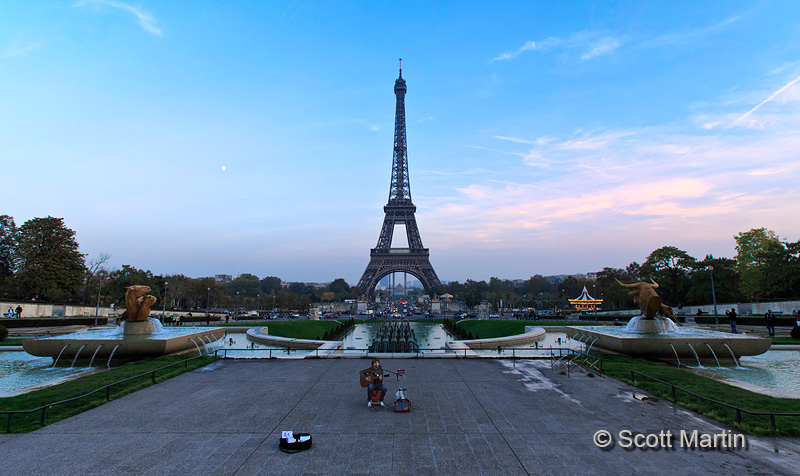
After leaving Paris we headed south towards the French Riviera, with a one night stop over in Lyon. On the way to Lyon we took a small detour and spent half a day at one of the most impressive houses in all of the world, the Palace of Versailles, home to Louis XIV. The Palace of Versailles will the subject of our next European post.
I trust you enjoyed the Eiffel Tower and thanks for taking the time to work through this post. It is much appreciated.

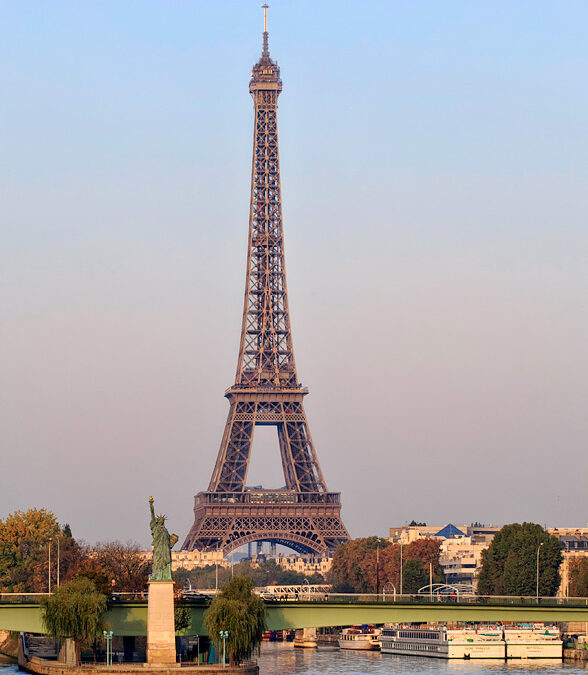
Hi Scott:
Just a quick note to tell you how much I’m enjoying your blog. Lois recommended your site some time ago, and it’s little wonder. Your photography is outstanding and your blog interesting and thoughtful. It’s particularly interesting to Lois and I since we have visited many of the same locations.
Yes, you’ve set a standard to which I can only aspire on my own blog. Keep up the good work!
Thanks Eric and I have enjoyed your blog as well. It’s always a pleasure to see and hear about others travel experiences, especially when we have been to many of the same areas. Thanks again Eric and I trust we enjoy each others blogs for years to come!
What a terrific post! This has to be one of your best with the huge variety of different angles and exposures of the Eiffel Tower, along with the very informative dialogue, well done! I hope you tossed some coins in the buskers guitar case 😉
Thanks Arni….the Eiffel Tower is one of those things you just can’t stop taking pictures of, so the odds are pretty good that you will get a few good ones! Yes, I think the busker was glad we were there!